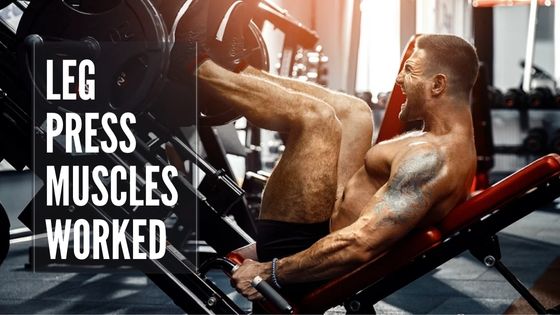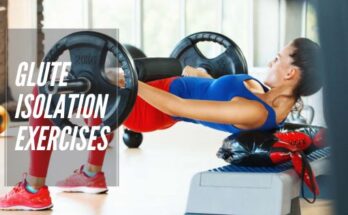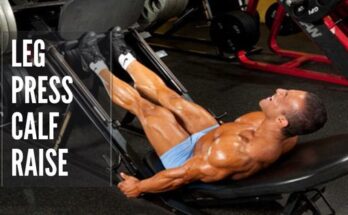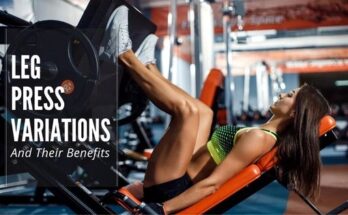Leg press – one of the most popular lower body exercises. Almost everyone does this exercise while training their legs. In this article, we’ll talk about leg press muscles worked, leg press variations, their benefits, and common mistakes that people do while performing leg presses.
How To Do Leg Press
The leg press is a simple and beginner-friendly exercise that anybody can do with slight guidance. Here is a step-by-step guide explaining how to do the leg press.
Step 1: Sit on the machine properly
Load the machine with the desired weight and sit comfortably on it. Put your head, back, and hips on the supporting pad. Make sure to keep your head, back, and, hips always in touch with the pad while performing the exercise.
If you feel that your lower back or hips are losing contact during the rep, stop the exercise as it can cause injury. This means that you can not control that much load, so reduce the weight and perform with a lighter weight.
Summary: Keep your back hips and head always in touch with the supporting pad.
Step 2: Set your feet right
After setting your upper body, it’s time to set your legs on the leg press. Put your feet on the footplate of the machine. Keep your feet shoulder-width apart as like in the squats.
Now there are multiple leg press variations on the basis of foot placement. Each variation hits your muscles differently. But for most lifters, feet shoulder-width apart in the center of the footplate is good enough.
Summary: Put your feet shoulder-width apart in the middle of the platform.
Step 3: Start the exercise with complete ROM
Now after fixing your stance, start the exercise by un-racking the weight sled. Lower the sled by bending your knees slowly and feel the load in your quads. Keep lowering the weight until your knees are close to your chest.
Try to build a good mind-muscle connection while lowering the sled so that you can maximize your muscle engagement and hypertrophy.
Now push the sled upwards by unbending your knees. Keep pushing the sled and stop just before your legs are straight.
Make sure to keep a slight bend in your knees, straightening your legs completely may cause serious injury to your knee joint.
Perform this exercise with a complete range of motion and keep repeating for 12 to 15 reps.
Summary: Lower the sled slowly until your knees are close to your chest then push it away and keep a slight bend in your knees at the top.
Leg Press Muscles Worked
The leg press is a great exercise for the legs which includes almost all the muscles of your lower body. So it engages your quads, hamstrings, glutes, and calves. However, it targets different muscles to different extents.
The major muscle in which the leg press works is the quadriceps. While hamstrings and glutes are engaged to a slightly lower degree than quads. Apart from this, the calves and adductors work as supporting muscles while doing the leg press.
Quadriceps is a huge muscle in front of your thigh which further comprise four muscles hence called the quadriceps (quad means four). It includes – rectus femoris, vastus medialis, vastus intermedius, and vastus lateralis.
During leg press, quad muscles do most of the work while pushing the sled away from your body. After reaching the top, the hamstrings and glutes come into play while lowering the sled.
However, the glutes also help in pushing the weight upwards. Glute is the single largest muscle of your body without any joints that helps you in various movements like running, jumping, etc.
In addition, calves and adductors work as supporting muscles throughout the movement. Their involvement is very less, so you need another exercise to train them.
Summary: The primary muscles worked by leg press is the quads, hams and glutes are secondary, whereas, calves works as just a supporting muscle.
Benefits of Leg Press
After understanding leg press muscles worked, let’s have a look at the benefits of leg press.
1. Increases quad development
As we have seen that leg press primarily targets the quad muscles, hence, it is one of the best exercises for developing muscular quads. It helps in building strength and hypertrophy in the legs.
So if you need bigger and more muscular thighs, you must add this exercise to your workout routine (1).
2. Beginners friendly
Unlike squats or deadlifts, you don’t need to do much work on your form while doing the leg press. The form and technique of this exercise are very simple and easy to learn.
Hence, it is beginners friendly and you can do this even on the first day of the gym.
3. Put less stress on the back
Injuries related to the lower back are very common among gym freaks. It’s not feasible to do some leg exercises like squats, lunges, and Romanian deadlifts if you have any lower back issues.
Here also, the leg press is the one for you. This exercise is very supportive for your back and especially your lower back. It minimizes the load on your back as your back is rested on the supporting pad (2).
Leg press allows you to train legs even after the injury as it minimizes the load on your spine.
4. Gives you the luxury to lift heavy
You can lift the heaviest weight in this exercise as compared to any other exercise in the gym. But make sure to lift only that load that does not interfere with your form. Do slow and complete reps for best hypertrophy results.
However, some people do ego lifting and put on too much weight than their capability. This puts unnecessary pressure on their knees, hips, and lower back which leads to injury in the long run.
5. Good for muscle imbalance
Another major benefit of doing leg presses is that it allows you to fix muscle imbalance if you have any. This exercise helps with muscle imbalance by allowing you to train one leg at a time.
As with arms, some people also have one leg dominant. Now in exercises like squats, this dominant leg takes more load and the other leg remains weaker in the long run. This creates muscle imbalance which can be corrected by doing one or two extra sets of single-leg leg presses with that weaker leg.
In leg press, you can train one leg at a time. This helps in fixing muscle imbalance by giving some extra sets to the weaker leg.
Leg Press Variations
This simple exercise has some variations too. You can manipulate the muscles worked during leg press by changing the position of your foot on the sled.
There are multiple leg press variations on the basis of foot placement. Let’s have a look at these leg press variations and muscles worked.
| Foot Placement | Dominating Muscle |
|---|---|
| High | Glutes and Hamstrings |
| Low | Quads |
| Wide | Inner thighs |
| Narrow | Outer thighs |
However, any of the above variations involve all three major muscles (quads, hamstrings, and glutes). But different foot placements do the muscle involvement differently.
Precautions and Safety Tips
No doubt, leg press is an easy exercise to perform but it still can harm you if you are not doing it safely. Here are the things you need to take care of while doing leg press.
1. lifting too much weight
Unlike other leg exercises like squats or lunges, it is easier to lift super heavy weight in this exercise. Due to which, some people add extra weight on the sled which they can not control.
This is the most common mistake I have seen people doing in the gyms. This extra weight won’t give you any extra benefit. On the contrary, you are giving your muscles less stimulus with an increased chance of injury.
You have to understand that leg press is not just about moving the weight up and down. For desired results, you must feel the weight in your muscles. And this can be done only if you choose a weight which you can control and complete your reps in full range of motion.
Pro tip: Lift for the muscles, not for the ego.
2. Butts not touching the pad
Make sure your buttocks are flat on the pad during the whole movement. If your butts are raising off the seat then that means something needs to be correct.
You can correct this either by reducing some weight off the sled or by adjusting your seat according to your height.
3. Moving head during the movement
Don’t lift your head off the seat while moving the weight. This might lead to injury in your neck. This is also an indication that you are lifting too much weight.
Keep your head still and well rested on the supporting pad. In fact, your whole upper body should be steady during the complete movement.
4. Straightening of legs
Never extend your legs fully in the top position. This complete extension of your legs makes your legs straight and puts all the load on your knees.
This removes tension from your muscles and puts immense stress on your knee joint which leads to serious injury.
Leg Press Muscles Worked: SUMMARY
This was the detailed and science-based article explaining leg press muscles worked. This compound exercise hits all your leg muscles but to different degrees.
The major impact of leg press is on your quads. While hamstrings and glutes are the secondary muscles that got a significant involvement. Apart from that, calves works just as a supporting muscle during the whole movement.




